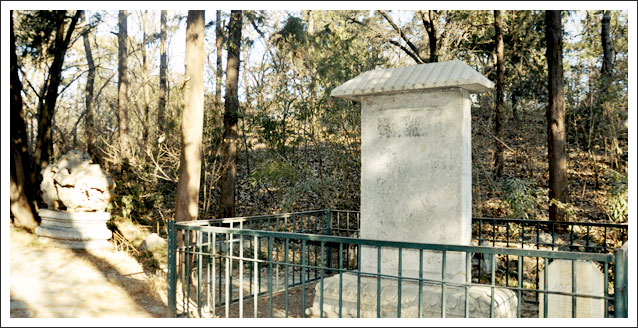文物保护

梅石碑 the Tablet Carved with Plums and Stone
文物时间:清乾隆
文物位置:临湖轩西南,俄文楼西北方土丘下
文物类别:碑刻
Time: Qianlong period, Qing dynasty.
Location: Southwest of Linhu pavilion, northwest of the hills by Russian Hall.
Category: Stone inscription
文物特色
此碑为圆明园“茜院”中遗留的故物,原存于北阁,1992年移至此地并加须弥座。碑身不高,有缺角,造型独特,上有石雕庑殿顶,下有莲花碑座,碑身上所镌刻的文字经过岁月的洗磨后有些漫漶不清,碑面刻有清高宗乾隆皇帝御笔题写的诗文,还有明代画家孙木大和蓝瑛刻画的一株苍劲有力的苔梅和一块玲珑奇巧的怪石。
文物缘起
明代画家孙木大突发奇想,在一块石碑上刻画了一株梅花,然后将石碑置放在芙蓉石旁边,梅石相映的胜景得以出现。此后,著名画家蓝瑛又刻石于碑上,奇梅怪石集于一碑,造就了著名的梅石碑。据史料记载,梅石碑上所刻画的石头是南宋高宗赵构的奇石“芙蓉石”,又称“德寿石”。
历史溯源
乾隆十六年,清高宗弘历第一次南巡,发现了扑地断残的梅石碑和仍然矗立于杂草丛中的奇石,抚摸良久不愿离去,乾隆以为梅石碑上的梅花和怪石是蓝瑛所画,题诗一首,以寄感慨,随后派人运到北京。乾隆十七年,石碑运到,被安放在了圆明园的长春园的茜院内,被赐名“青莲朵”,由乾隆亲笔题于石上,成为茜院八景之一。
乾隆三十年第四次南巡发现梅石碑上的梅花不是蓝瑛所画,于是又题诗一首,并作文以纠正先前的错误,同时叫人重新复制了一块梅石碑,并把他所作的诗文镌刻于所复制的碑上。乾隆三十二年,乾隆又命人重新摹刻梅石碑一块,放在圆明园茜院门左的碑亭中,与“青莲朵”相依而立。
圆明园遭到英法联军焚毁时,梅石碑和青莲朵却奇迹般保存下来,“青莲朵”于1915年前后于圆明园移至当时新建的中山公园内,但经过800余年的风雨沧桑后早已不是青莲形状。而茜院的梅石碑在燕大建校后移放于燕园。为避免梅石碑再受风雨侵蚀和人为破坏,校方特意在碑顶做了石雕庑殿顶,并用铁护栏保护起来。1996年,在碑前的榆叶梅东侧,仿照青莲朵配置了三块太湖石小品。如此,奇梅怪石相映成趣的胜景得以再现。
Distinguishing feature
This tablet is the relic remained in Qian yuan of Yuanmingyuan, used to be kept in the Miner Hall. It was moved here and added a Sumeru seat in 1992. The peculiar-model tablet isn't high and has a gap on the corner, with hip roof on the top and lotus foundation on the bottom. As time flies, the words on the tablet became blurring. There is a poem wrote by Qianlong Emperor, as well as a prune tree and exquisite picturesque stone painted by Sun Muda and Lan Ying in Ming Dynasty.
Hiatory
Ming painter Sun Muda once came up to carve a plum tree on a tablet and put in next to rosy quartz. Hence there was a beautiful aspect of plums and rock shine upon each other. Afterwards the famous painter LanYing carved a rock on the tablet. That’s how the famous Meishi Tablet came into existence. According to historical materials, the rock carved on the tablet is the rosy quartz of the Emperor Zhaogou. It was also called Deshou stone.


